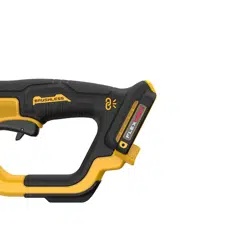Loading ...
Loading ...
Loading ...

13
ENGLISH
for use with depressed center wheels (Type 27) and
hubbed grinding wheels (Type 27). The same guard is
designed for use with sanding flap discs (Type 27and
29) and wire brushes. Grinding and cutting with
wheels other than Type 27and 29require different
accessory guards not included with tool. Mounting
instructions for these accessory guards are included in
the accessorypackage.
1. Open the guard release lever
9
. Align the lugs
14
on
the guard with the slots
15
on the gearcase.
2. Push the guard down until the guard lugs engage and
rotate freely in the groove on the gear casehub.
3. With the guard latch open, rotate the guard
8
into the
desired working position. The guard body should be
positioned between the spindle and the operator to
provide maximum operatorprotection.
4. Close the guard latch to secure the guard on the gear
case. You should not be able to rotate the guard by hand
when the latch is closed. Do not operate the grinder with
a loose guard or the clamp lever in openposition.
5. To remove the guard, open the guard latch, rotate the
guard so that the arrows are aligned, and pull up on
theguard.
NOTE: The guard is pre‑adjusted to the diameter of the gear
case hub at the factory. If, after a period of time, the guard
becomes loose, tighten the adjusting screw
17
with clamp
lever in the closedposition.
CAUTION: Do not tighten the adjusting screw with the
clamp lever in open position. Undetectable damage to
the guard or the mounting hub mayresult.
CAUTION: If guard cannot be tightened by adjusting
clamp, do not use tool and take the tool and guard to a
service center to repair or replace theguard.
Flanges and Wheels
WARNING: To reduce the risk of serious personal
injury, turn unit off and remove the battery pack
before making any adjustments or removing/
installing attachments or accessories. An
accidental start‑up can causeinjury.
Mounting Non-Hubbed Wheels (Fig. H, I)
WARNING: Failure to properly seat the flanges and/or
wheel could result in serious injury (or damage to the
tool orwheel).
CAUTION: Included flanges must be used with
depressed center Type 27/42 grinding wheels and
Type1/41 cutting wheels. Refer to the Accessories
Chart for moreinformation.
WARNING: A closed, two‑sided cutting wheel guard
is required when using abrasive cutting wheels or
diamond‑coated cutting wheels.
WARNING: Use of a damaged flange or guard or
failure to use proper flange and guard can re sult in
injury due to wheel breakage and wheel contact. Refer
to the Accessories Chart for moreinformation.
Guards
CAUTION: Guards must be used with all grinding
wheels, cutting wheels, sanding flap discs, wire
brushes, and wire wheels. The tool may be used
without a guard only when sanding with conventional
sanding discs. Refer to Figure A to see guards provided
with the unit. Some applications may require
purchasing the correct guard from your local dealer or
authorized servicecenter.
• Surface grinding with a Type 1/41/A guard may cause
the guard to interfere with the workpiece resulting in
poorcontrol.
• Using a Type 27/B guard for cutting‑off operations with
bonded abrasive wheels will increase the risk of exposure to
emitted sparks and particles, including exposure to wheel
fragments in the event of wheel burst.
• Using incorrect guards for cutting‑off and facial operations
in concrete or masonry can increase the risk of exposure to
dust and loss of control resulting inkickback.
• Using an oversized wire‑wheel with any guard may
cause the wires to catch on the guard leading to breaking
ofwires.
• Always use appropriate guards for the specifictask.
NOTE: Edge grinding and cutting can be performed with
Type 27wheels designed and specified for this purpose; 1/4"
(6.35 mm) thick wheels are designed for surface grinding
while thinner Type 27wheels need to be examined for
the manufacturer's label to see if they can be used for
surface grinding or only edge grinding/cutting. A Type 1/41
guard must be used for any wheel where surface grinding
is forbidden. Cutting can also be performed by using a
Type1/41 wheel and a Type 1/41guard.
NOTE: See the Accessories Chart to select the proper guard
/ accessorycombination.
Mounting and Removing Guard (Fig. F)
CAUTION: Guards must be used with all grinding
wheels, cut‑off wheels, diamond coated wheels,
sanding flap discs, wire brushes, and wire wheels.
The tool may be used without a guard only when
sanding with conventional sanding discs. Some
DEWALT models are provided with a guard intended
Rotating the Gear Case (Fig. E)
To improve user comfort, the gear case will rotate 90° for
cuttingoperations.
1. Remove the four corner screws (T25) attaching the gear
case to motorhousing.
2. Without separating the gear case from motor housing,
rotate the gear case head to desiredposition.
NOTE: If the gear case and motor housing become
separated by more than 1/8" (3 mm), the tool must be
serviced and reassembled by a DEWALT service center.
Failure to have the tool serviced may lead to motor and
bearingfailure.
3. Reinstall screws to attach the gear case to the
motor housing. Tighten screws to 28 in.‑lbs. torque.
Overtightening could cause screws tostrip.
Loading ...
Loading ...
Loading ...
